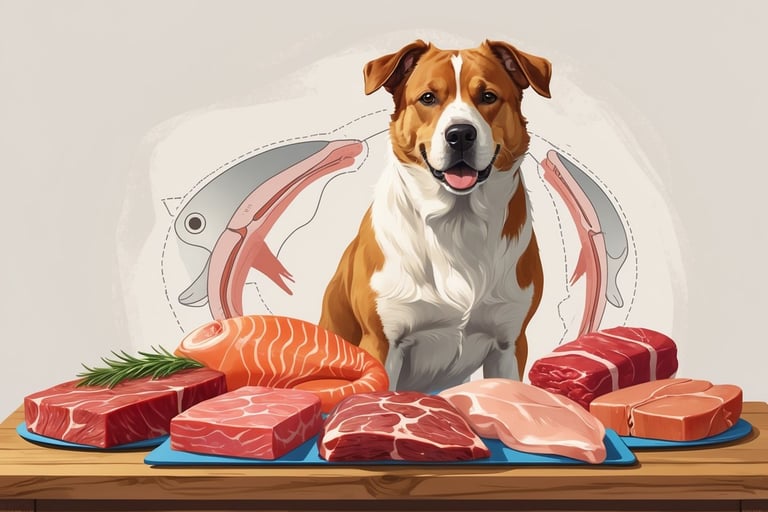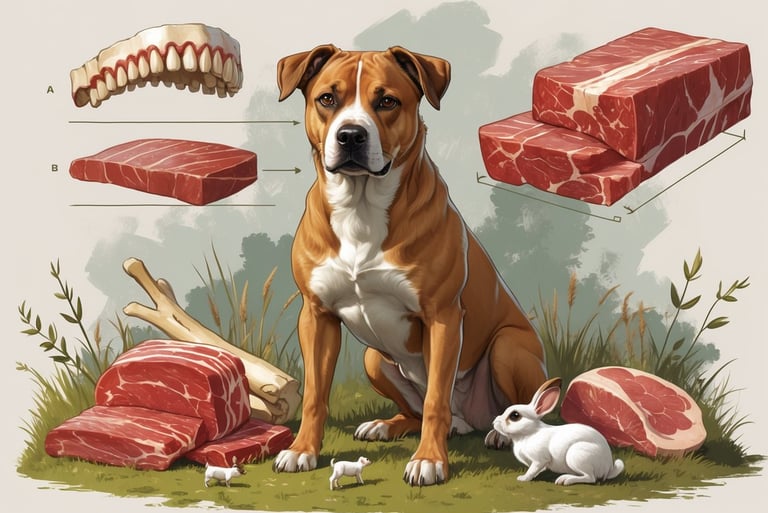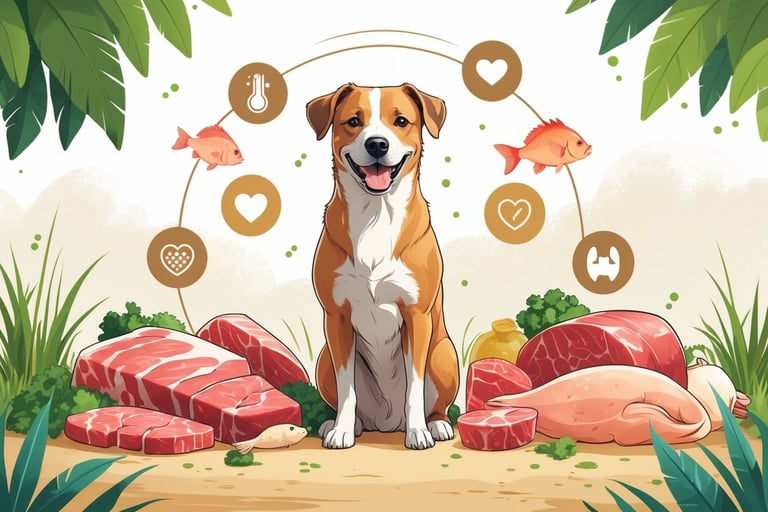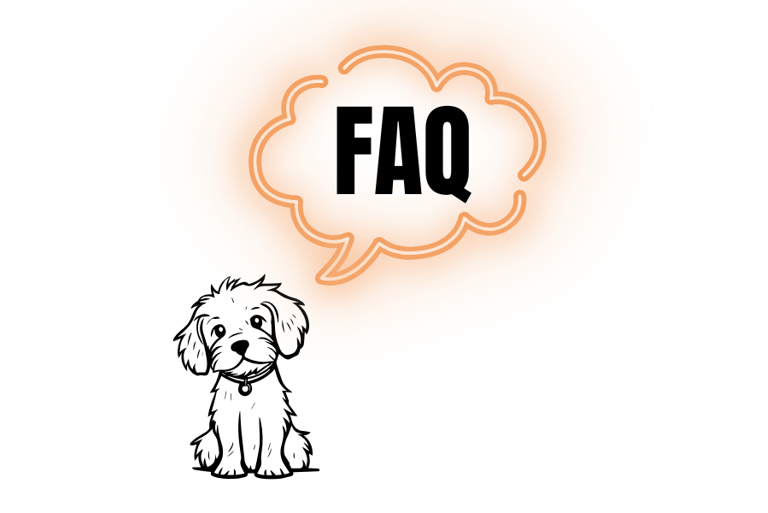The Argument for the Carnivore Diet for Dogs
Understanding Canine Nutritional Biology and Natural Feeding Patterns
DOG NUTRITION TIPS
10/1/20257 min read
The Argument for the Carnivore Diet for Dogs
Many dog owners struggle with choosing the right diet for their pets, but understanding your dog's true nature can make this decision clearer. Dogs are carnivores by design, with digestive systems and nutritional needs that align best with a meat-based diet. This biological reality suggests that carnivore diets may be the optimal way to feed dogs, despite the popularity of grain-filled commercial foods.
The debate between carnivore and omnivore classification for dogs has created confusion among pet owners. While some experts argue dogs have adapted to digest plant matter, their anatomy and evolutionary history tell a different story. Their wolf ancestors thrived on meat-only diets, and domestic dogs retain many of the same digestive characteristics.
This approach to canine nutrition offers potential benefits ranging from improved digestion to better coat quality. However, pet owners often worry about nutritional completeness and practical concerns when considering such a significant dietary change. Understanding both the science behind canine nutrition and addressing common misconceptions can help dog owners make informed decisions about their pet's health.
Understanding the Carnivorous Nature of Dogs
Dogs share key traits with their wolf ancestors and possess specific body features designed for meat eating. Their teeth, jaws, and digestive system show clear signs of carnivorous adaptation when compared to plant-eating animals.
Ancestral Diets and Evolution
Wolves are obligate carnivores with bodies designed to thrive on meat-only diets. Their sharp teeth, powerful jaws, and digestive systems are perfectly adapted for processing flesh.
Dogs descended from these wild canids thousands of years ago. This evolutionary link means dogs inherited many of the same physical traits that made wolves successful hunters.
The domestication process changed some aspects of dog biology. However, the core carnivorous features remain largely intact in modern dogs.
Key evolutionary traits include:
Sharp, pointed teeth for tearing meat
Strong jaw muscles for crushing bones
Short digestive tract typical of meat eaters
High stomach acid levels for breaking down protein
Biological Adaptations for Meat Consumption
Dogs are biologically designed to thrive on animal-based protein diets. Their body structure shows multiple adaptations for processing meat efficiently.
Dental Structure:
42 teeth designed for cutting and tearing
Large canine teeth for gripping prey
Carnassial teeth that work like scissors
Limited flat grinding surfaces
Digestive System Features:
Stomach pH of 1-2 when empty (highly acidic)
Short small intestine relative to body size
Simple stomach structure
Fast transit time for food processing
Dogs lack several features common in plant-eating animals. They have no grinding molars for breaking down tough plant fibers. Their saliva contains no amylase enzyme for pre-digesting starches.
Comparing Canines to True Carnivores
Dogs share many traits with obligate carnivores like cats and wolves. Some veterinary professionals argue dogs should be classified as carnivores rather than omnivores.
Similarities to obligate carnivores:
High protein requirements
Efficient fat digestion
Limited carbohydrate processing ability
Preference for animal-based foods
Key differences:
Dogs can digest some plant matter
They produce small amounts of amylase
More flexible metabolism than strict carnivores
Can survive on varied diets when necessary
The debate centers on whether these differences make dogs omnivores or simply flexible carnivores. Research suggests dogs are facultative carnivores that need animal protein but can benefit from some plant foods.
Benefits of a Carnivore Diet for Dogs
A carnivore diet can provide significant health improvements for dogs through better protein absorption, healthier skin from essential fatty acids, and sustained energy from species-appropriate nutrition. These changes often become visible within weeks of transitioning to an all-meat diet.
Improved Digestive Health
Dogs possess shorter digestive tracts designed for processing meat efficiently. Their stomach acid has a pH of 1-2, which breaks down animal proteins and bones effectively.
Plant-based fillers like corn, wheat, and soy can cause digestive stress in many dogs. These ingredients require different enzymes that dogs produce in limited quantities.
A carnivore diet eliminates these problematic ingredients completely. Dogs on meat-only diets typically experience:
Smaller, firmer stools due to higher nutrient absorption
Reduced gas and bloating from eliminating hard-to-digest plant matter
Less frequent bowel movements as the body uses more of what it consumes
Raw meat contains natural enzymes that aid digestion. These enzymes get destroyed during commercial food processing but remain intact in fresh meat.
Many dog owners report their pets stop experiencing chronic diarrhea or constipation after switching to carnivore diets. The simplified ingredient list makes it easier to identify and eliminate food sensitivities.
Enhanced Skin and Coat Quality
Animal fats provide omega-3 and omega-6 fatty acids in optimal ratios for dogs. These fats support skin barrier function and coat development.
Commercial dog foods often contain damaged fats from high-heat processing. Fresh meat and organs deliver these nutrients in their natural form.
Dogs on carnivore diets typically develop:
Shinier, softer coats from improved fat absorption
Reduced itching and scratching as inflammatory ingredients are removed
Faster healing of minor cuts and scrapes
Organ meats like liver contain high levels of vitamin A, which supports skin cell regeneration. Zinc from red meat helps maintain healthy skin structure.
Advocates report improved skin and coat health as one of the most noticeable changes. Many dogs with chronic skin issues see improvements within 4-6 weeks.
The elimination of common allergens like grains and legumes often resolves skin problems that owners thought were permanent conditions.
Optimized Energy and Vitality
Meat provides complete amino acid profiles that dogs need for muscle maintenance and energy production. Plant proteins are often incomplete and harder for dogs to utilize.
Fat serves as the primary energy source for dogs in their natural state. Carbohydrates can cause energy spikes and crashes that meat-based diets avoid.
Dogs on carnivore diets frequently show:
More consistent energy levels throughout the day
Increased muscle mass and definition
Better endurance during exercise and play
The high bioavailability of nutrients in meat means dogs need smaller portions to meet their nutritional needs. This prevents the sluggishness that can come from overeating low-quality foods.
Improved energy levels are commonly reported benefits of switching to species-appropriate nutrition. Working dogs and active breeds often perform better on high-protein, high-fat diets.
Mental alertness also tends to improve as blood sugar levels stabilize without constant carbohydrate intake.
Addressing Common Concerns and Misconceptions
Many dog owners worry about nutritional gaps and health risks when considering a carnivore diet. Understanding proper nutrient balance and risk management helps pet owners make informed decisions about their dog's dietary needs.
Nutritional Balance and Requirements
Dogs require specific nutrients that must come from carefully planned meat-based diets. Essential vitamins like A, D, E, and K are naturally present in organ meats and animal fats.
Key nutrients dogs need:
Protein (22-25% for adult dogs)
Fat (8-15% minimum)
Calcium and phosphorus (proper 1.2:1 ratio)
B vitamins from liver and muscle meat
Omega-3 fatty acids from fish
Organ meats provide crucial vitamins that muscle meat alone cannot supply. Liver contains high levels of vitamin A and B vitamins. Heart muscle provides taurine and CoQ10.
Raw bones supply calcium and phosphorus in the correct ratios. Ground bone meal can substitute for whole bones when feeding ground meat diets.
Veterinary experts acknowledge new theories about dog nutrition that challenge traditional omnivore classifications. Proper planning ensures all nutritional needs are met through animal-based sources.
Potential Risks and How to Mitigate Them
Bacterial contamination poses the biggest risk with raw carnivore diets. Proper food handling and sourcing reduce these dangers significantly.
Risk mitigation strategies:
Source meat from reputable suppliers
Freeze meat for 72 hours before feeding
Clean all surfaces and bowls thoroughly
Transition gradually over 7-10 days
Bone fragments can cause choking or intestinal blockage. Raw bones are softer and safer than cooked bones, which become brittle and dangerous.
Nutritional imbalances occur when owners feed only muscle meat. Including organ meats (10-15% of total diet) and bones (10-20% of total diet) prevents deficiencies.
Addressing safety concerns about carnivore diets involves understanding proper ratios and preparation methods. Working with a veterinarian familiar with raw feeding helps monitor the dog's health during transition periods.
Frequently Asked Questions
Dog owners considering a carnivore diet often have concerns about safety, nutrition, and proper preparation. Understanding the benefits and risks helps pet owners make informed decisions about their dog's feeding plan.
What are the health benefits of a carnivore diet for dogs?
A carnivore diet can improve digestive health in many dogs. The high protein content supports muscle development and maintenance. Many owners report shinier coats and increased energy levels.
Dogs may experience better dental health from chewing raw bones and meat. The natural enzymes in raw meat can aid digestion. Some dogs with food allergies find relief when eating only meat.
Weight management becomes easier with high-protein, low-carbohydrate meals. The diet matches what dogs consumed in the wild for centuries before human domestication.
Is it safe to feed my dog only raw meat?
Raw meat feeding requires careful handling to prevent bacterial contamination. Fresh, high-quality meat from trusted sources reduces health risks. Proper storage and preparation are essential for safety.
Some dogs adapt well to raw meat diets. Others may experience digestive upset during the transition period. Gradual introduction helps dogs adjust to the new diet.
Puppies, elderly dogs, and dogs with weak immune systems face higher risks. These dogs may benefit from cooked meat instead of raw options.
How does a carnivore diet compare to traditional dog foods nutritionally?
Carnivore diets provide complete proteins with all essential amino acids. Traditional dog foods often contain grains and vegetables as filler ingredients. Meat-based diets offer higher protein density per serving.
Commercial dog foods must meet specific nutritional standards. Homemade carnivore diets require careful planning to avoid deficiencies. Essential vitamins and minerals may need supplementation.
Traditional foods provide consistent nutrition with less preparation time. Carnivore diets offer more natural ingredients but require more owner involvement.
What precautions should I take when preparing a homemade carnivore diet for my dog?
Clean all surfaces and tools before and after meat preparation. Wash hands thoroughly to prevent cross-contamination. Store raw meat at proper temperatures to prevent spoilage.
Use separate cutting boards for dog food preparation. Freeze meat for several days to kill potential parasites. Thaw frozen meat safely in the refrigerator.
Buy meat from reputable suppliers who follow safety standards. Avoid meat that smells off or appears discolored. Check expiration dates before feeding.
How can I ensure a balanced carnivore diet for my dog?
Include organ meats like liver, kidney, and heart for essential nutrients. These organs provide vitamins and minerals not found in muscle meat alone. Aim for 10-15% organ meat in the total diet.
Rotate different protein sources including beef, chicken, fish, and lamb. This variety prevents nutritional gaps and keeps meals interesting. Each protein offers different nutrient profiles.
Consider adding bone meal or ground bones for calcium and phosphorus. Work with a veterinary nutritionist to create balanced meal plans. Regular blood tests can monitor nutritional status.
What are the risks associated with feeding dogs a strictly meat-based diet?
Nutritional imbalances can develop without proper planning and supplementation. Dogs may miss important vitamins and minerals found in other foods. Calcium and phosphorus ratios must stay balanced for bone health.
Bacterial infections from contaminated meat pose serious health risks. Salmonella and E. coli can make dogs and their families sick. Some veterinary experts question whether dogs are obligate carnivores like cats.
Cost and preparation time increase significantly compared to commercial foods. Finding consistent, high-quality meat sources can be challenging. Travel and boarding become more complicated with special diets.








Connect
Reach out for support and inquiries.
Subscribe
contactbowloflove@gmail.com
© 2025. All rights reserved.
